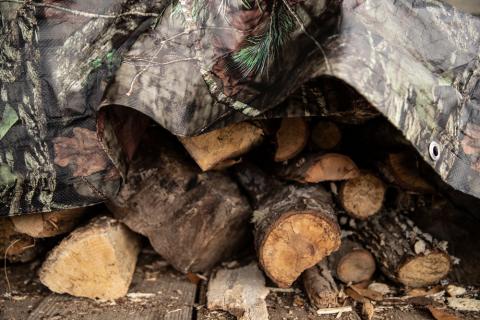
Bass fishing in the wintertime can give you access to bigger fish and quieter days on the lake. With some general knowledge, it’s also not that difficult. All you need to do is adjust to the wintertime habits of bass and try your luck at winter fishing. To help you do just that, here is Mossy Oak’s expert guide to winter bass fishing. We’ll help you figure out what bait to use, when to head out, and where to fish.
Best Baits for Winter Bass Fishing
Before you set out to bass fish in the winter, remember that the fish’s metabolism is at an all-time low. This means their digestive system can’t handle larger bait, so it’s better to keep it simple. Opt for lightweight bait. A quarter ounce or, at most, three-eighths of an ounce is as heavy as you need, and there’s seldom a reason for bait to exceed three and a half inches in length.
Some good examples of winter bass bait include a rapala shad rap, a hair jig, and soft plastic baitfish. If you use a hair jig, remember that you don’t need a trailer. A bit of deer hair will work just fine.
Some people try to go larger, but, if you want to get as many bites as possible and increase your odds of catching a big fish, keep it small and light. These guys don’t have their warm weather appetite.
When to Catch Bass in the Winter
When it comes to wintertime bass fishing, many people think that the afternoon is the only good time to fish. Indeed, the hours between 2 p.m. and sunset are often some of the best hours to fish: The sun has warmed up the water, the baitfish are active, and the bass are moving around. Afternoons are especially good on particularly cold days.
However, afternoons aren’t your only option. Daylight is also one of the best times to catch bass—smallmouth bass in particular. If you’re out from an hour or so before sunrise until a few minutes after the sun comes up, you’re going to be almost sure to get some bites.
Where to Find and Catch Bass in the Winter
The number one rule of fishing is to fish where the fish are. It’s important to know where the fish like to spend the winter. Bass like cover, whether that is grass, wood, or docks, but rock fixtures and formations in the water tend to provide good natural cover for them.
Water Depths
It’s key to remember that depth is relative and how deep you fish all depends on the lake you’re fishing. Some lakes only get ten feet deep, while others are forty or fifty feet deep. If bass like to spend their summers at a depth of ten feet in a given lake, head out to where it gets thirty or forty feet deep. If they spend their summers in three feet of water, head out to where it’s ten feet deep.
It tends to be helpful to situate your boat near the deeper parts of the lake, but this doesn’t mean you have to be right on top of the deepest part of the body of water. You also have to monitor water clarity. In many ways, clarity is even more important than water warmth, so you may want to consider some innovations in bass fishing like the Humminbird 360 Image Trolling Motor System /our-obsession/blogs/fishing/brandon-palaniuk-on-new-electronics-for-bass-fishing so you can see the bottom as well as all around your boat for the best fish.
As a general rule, the dirtier the water, the shallower the baitfish will be. The clearer the water, the deeper the baitfish will be. Bass will follow the baitfish even though they aren’t feeding like they were in the fall or summer. Like everyone else, they just like to be near their food source, and, for this, clarity is a better determinant than water warmth of how deep the bass and the baitfish will swim.
Feeding Patterns
In the winter, bass turn to much of the same food sources they do at other times of the year; they just eat less of it. Crawfish might go away for the winter, meaning the crawfish baits may work. However, shad or baitfish imitation baits are a safer bet.
Here’s why: When it gets cold, baitfish have the habit of dying out. They don’t often die out completely, but you will likely see little red fins floating on the service. They can’t take the cold that well. This means that bass will be eager to find and eat more baitfish, making shad and baitfish imitation baits good choices. Umbrella rigs are also a good idea, as they imitate schools of baitfish well.
Winter Bass Fishing Secrets
When you head out fishing in winter, it’s essential to have a realistic set of expectations to know when you’ve actually been successful. If you have realistic expectations, you’ll be able to monitor how you’re doing and not get discouraged.
Bass don’t bite in the winter like they do in the spring or summertime. On a good day, you may get ten bites. A great day might look like twelve to fifteen bites, with an amazing day being at around twenty bites.
The average size of the fish tends to be better in the winter. They’ve had all year to get big, and now you can enjoy a larger fish.
Finally, remember that bass need access to deeper water. This doesn’t mean they need water that’s fifty feet deep: “Deeper” is relative to the body of water in question.
Final Word
Whether you’re preparing to try your hand at bass fishing for the first time or you want to improve on your growing skillset, this expert guide can help you make the most of your wintertime trip. Remember to select your bait for the slowed digestive system of the bass and head out at daylight or during the afternoon.
Bear in mind that necessary depth is relative, and that water clarity is, in many ways, even more important than water warmth. Follow the feeding patterns, which also have a lot to do with the temperature and water clarity. Finally, make sure you’ve set realistic expectations. If you do all of these things, you stand a much better chance at a good day of fishing and catching sizable winter bass.




























